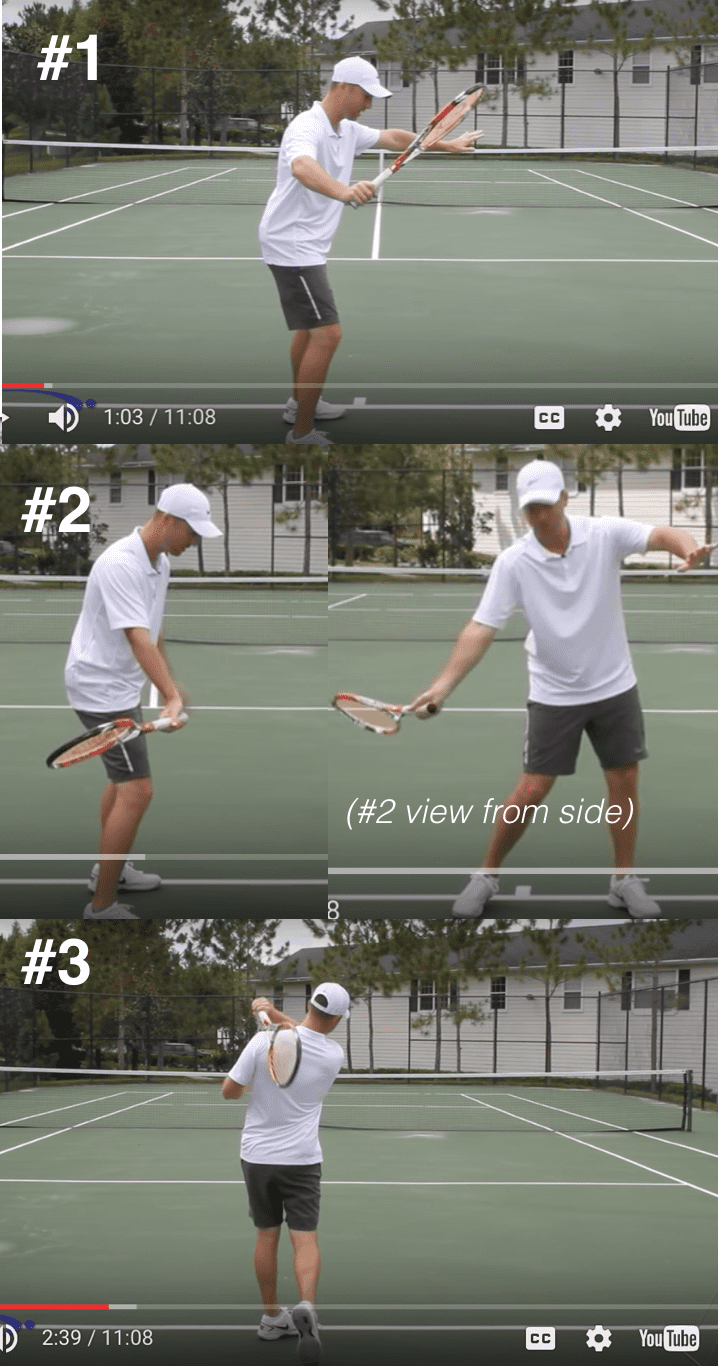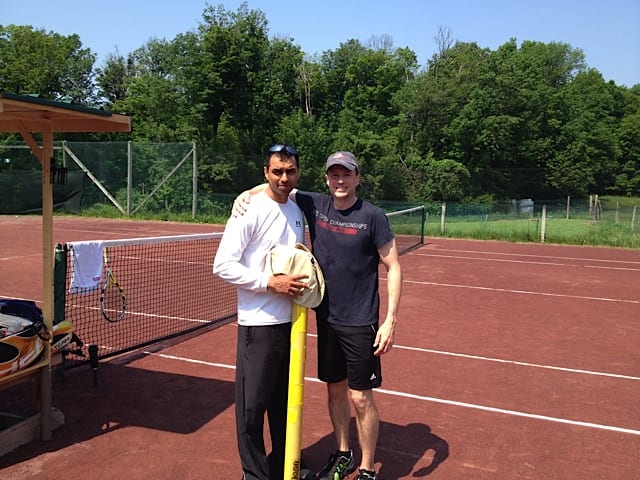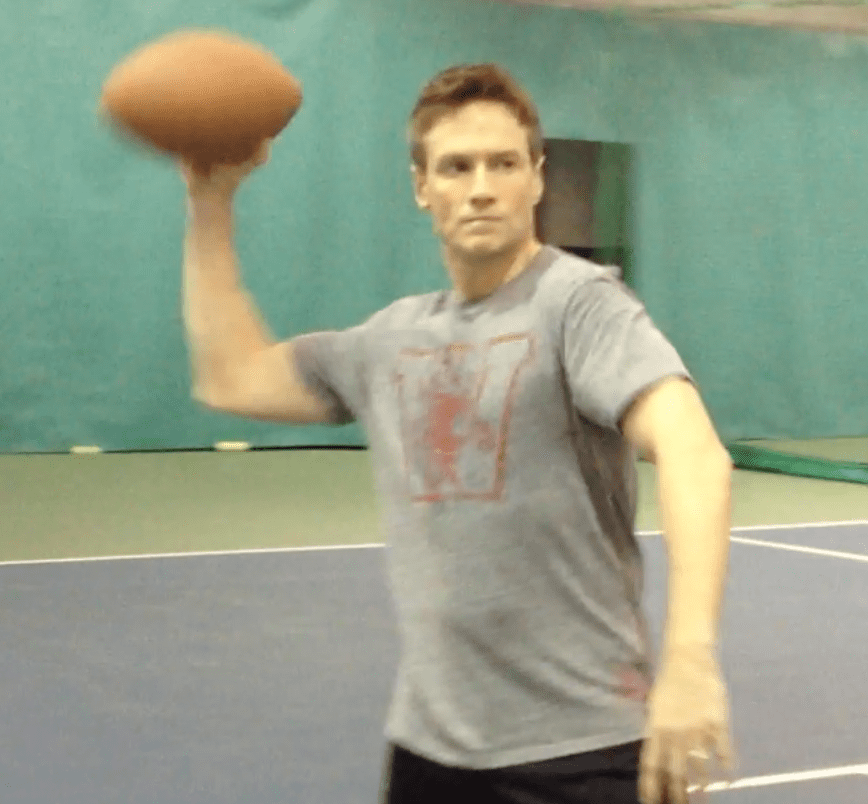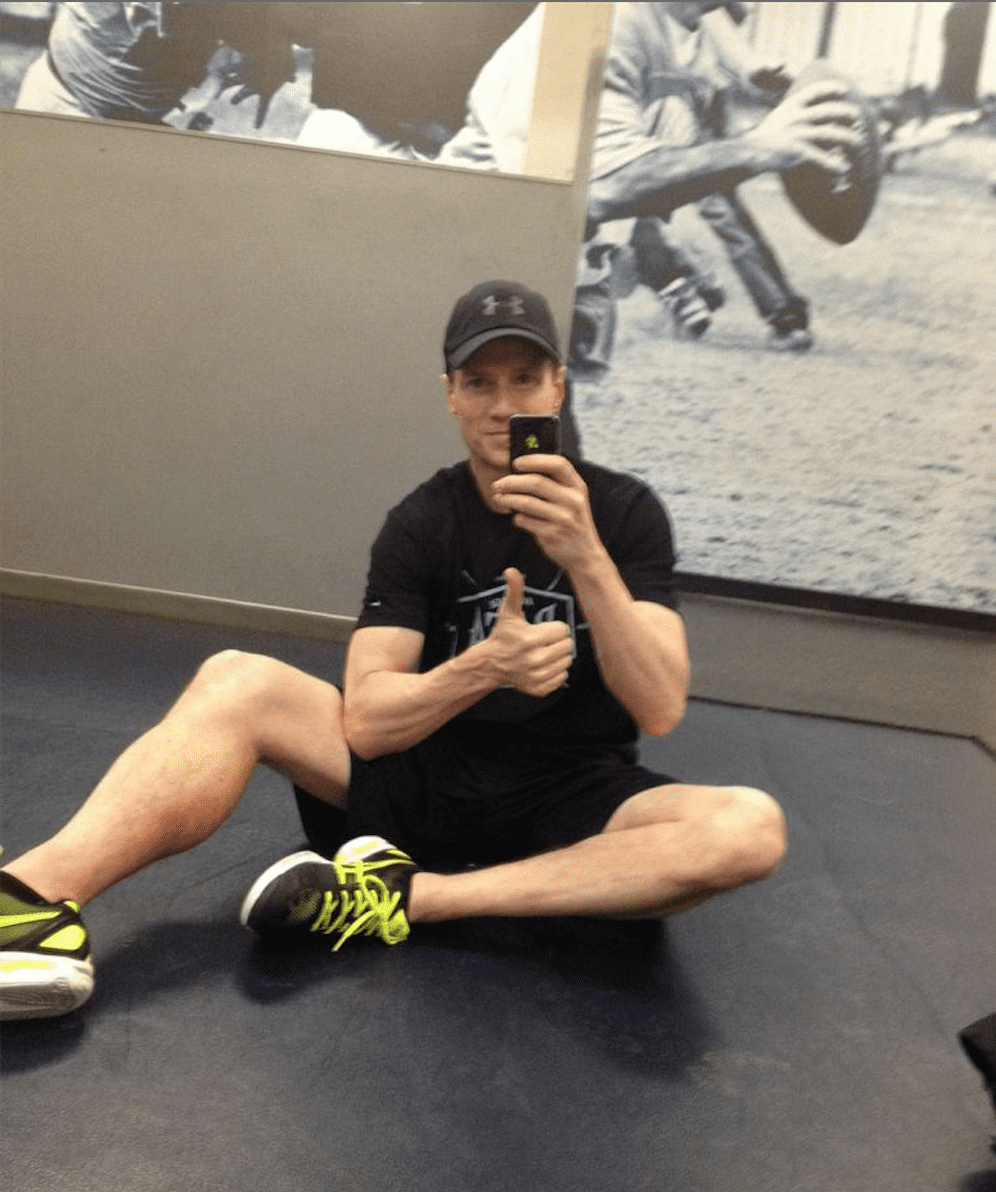Want more topspin? Think “hello/goodbye”
“Give me more TOPSPIN!”
“Get under the ball!”
“Stop compressing the ball!”
“Turn the ball!”
“No, that’s too flat!”
For years, so many coaches barked out words like this to me over and over. I knew they were right, but every time I wanted to scream:
“YES, I desperately WANT to do that … But HOW? What’s am I doing wrong mechanically that’s preventing me from adding more spin all the time?”
I had been working my tail off for so long with ball machines, trying to analyze video, asking different pros for help. But I kept hitting a wall and I couldn’t pinpoint the problem. My first light bulb moment happened a few years ago thanks to the brilliant pro Saif Syed at Total Tennis. After hitting erratic forehands for about an hour in my attempt to add more spin I was about to lose it. After the morning drilling session we had a private and I vented, explaining my desperate longing to hit more topspin consistently.
In Saif’s trademark calm and wise Yoda-like manner, he said: “Talk to me. Tell me what’s going on in your head.” I explained:
“I’ve been analyzing slow-motion tape of pros hitting the modern forehand. Say you assigned a number 1-8 to each phase of the stroke, from early preparation to finish: I feel like I’m clear on everything but somewhere around number 5– the part just before impact where something happens fast with the racquet head dropping along with a change in the wrist and the hips start opening up and… well, I’m not sure what I’m doing wrong in trying to imitate that. And I’ve gotten about 5 different explanations and instructions from 5 different pros and now my mind is just cluttered with competing inputs.”
Saif asked me to demonstrate what I thought I was seeing on film. In my mind, I was imagining this video (with the point of confusion being at 0:09-0:11):
When I showed Saif how my body was translating these images into action, he immediately saw the problem and calmly suggested something along these lines:
“Your preparation looks good– good shoulder turn, initial racket head position correct. But then [referring to what would be around 0:09 of the video above] there’s something missing: you need to keep your wrist really relaxed and allow it to rotate clockwise– kind of like the motion you use when opening a doorknob, or like waving “HELLO” to someone sitting over on the sidelines to your right. This will happen naturally as your hip rotation begins if your arm is relaxed. Your racket face should stay slightly closed the entire time, which it needs to be to generate topspin… then you need to accelerate and swing through with the proper finish.”
I went back to the baseline and… BINGO!!! Dramatic difference. Lots more topspin on every shot.
The next epiphany came a few months later, when I was home for the holidays and took a lesson from Seth Hanapole in Massachusetts. Seth helped me break another habit that was holding my forehand back. Turns out I was unintentionally breaking my wrist slightly at contact (wrist flexion). A big no no. Seth helped me see something that many other pros would reinforce over time: great players don’t make a deliberate effort to do anything with their wrist at contact– when the wrist is relaxed and the set-up is correct, the wrist naturally does the right thing at impact and in the follow through.
What did the “right thing” look and feel like? Turns out, a lot like waving “GOODBYE” — like a wave right to left (I’m a righty) as I brushed up on the ball and followed through. For me, “GOODBYE” worked better as shorthand for what others have called the “WINDSHIELD WIPER” or “CHECK YOUR WATCH” concepts. Here’s how Seth described it:
All of the above helped me enormously, but everything really began to come together after I discovered the video below by Clay Ballard on “Lag and Snap” [aka “Stretch Shortening Cycle”], which adds tremendous clarity to this set of questions around proper wrist action. I strongly recommend watching Clay’s entire free series on the forehand, which puts all of this into a fuller context:
Summary of Clay Ballard’s key concepts
Orientation for a right-hander – just reverse if you’re a lefty
#1. Racquet face should be at about 45 degree angle in preparation, pointing towards around 3:00pm
#2. Wrist then rotates clockwise like turning doorknob (e.g. “HELLO” to someone on the right as above) such that the angle of your racquet points back to around 7:30pm. Note: the arm itself stays in front — it’s the racquet face that is “lagging” back and pointing to around 7:30pm.
#3. Then as you release and follow through, the wrist naturally “turns the doorknob” the other way (counter clockwise). Note the racquet head does not move vertically straight up-and down, but rather at a 45 degree angle so it has force.
See full video here
A few other videos I have found very helpful, each using slightly different terms and analogies to explain what happens to the arm, wrist and racquet during the part of the swing I’ve been obsessing about:
* USPTA pro John Craig’s videos: “Truth about Lag and Snap” and “Lag and Snap revisited.”
* Rick Macci’s: Improved Forehand Technique with Rick Macci (see especially starting around 7-minute mark).
* Ian Westermann’ Roger Federer Forehand Revealed (see especially around 5-minute mark)
Importantly, all of the above underscore the idea that if you set up properly such that you can correctly “pull” the racquet forward, your wrist (if relaxed!) will do the right thing, the racquet will go down and back naturally on its own, and the butt capp will “find its position” on its own.
Finally, the other absolutely critical insight I’ve gained about great forehand technique (albeit not directly related to generating topspin) is about where power comes from in forehands:
(1) Optimal use of the kinetic chain through which physical energy is stored and released–first through proper loading of the legs and transferred through the hips (see e.g. Tim Mayotte on “What Makes Tennis Technique Modern?“), then finally through the stretch-shortening cycle involving the laid-back wrist that Clay Ballard discusses in the video above. The magic happens when all of this works together seamlessly and naturally– no one part being “forced.”
(2) Speed (not muscling) of the swing, which somewhat counterintuitively can only be achieved through having a loose arm.
(3) Transfer of energy forward and into the court (not laterally, which many of may think we should do if we misinterpret the “windshield wiper” or “brushing up” concept).
Throughout all of this research and trial and error, I’ve encountered a ton of passionate views and controversy. The reality is that all the shorthand terms (windshield wiper, lag and snap, etc) all have shortcomings: they can connote very different ideas to different people, which can easily lead to misinterpretation and bad execution. Many renowned technique experts understandably abhor the term “lag and snap” because (1) the idea of “lagging” is misleading given how quickly everything happens and can make players wrongly try to lag in ways that are unnatural; and (2) similarly, the word “snap” may encourage players to (wrongly) try to flick their wrist at contact. Moreover, the reality is that great players fine-tune aspects of technique in real time depending on what they want to do with the ball– the idea that we should try to hit the “perfect forehand” the same way every shot is a red herring.
Yet there are certain common technical elements to great forehands, and I hope the ideas above provide some of the clues that help you on your journey to discover what works for you.
Two of my favorite guys to model my forehand after are featured below–both excellent pros who I’ve worked with at Total Tennis: Saif Ali and Marlon dal Pont. Watch in particular:
- Smooth takeback/shoulder turn
- Compact and efficient C-loop on take back: the racquet is in perfect position (not too far back) to execute “HELLO/GOODBYE” the instant the ball is lands in the hitter’s “zip code”
- Athletic position maintained throughout, knees bent
SAIF ALI
MARLON DAL PONT (apologies for the quality- only had my phone that day!)
JUST FOR FUN
In his spare time Marlon performs insane tennis tricks…
*Top Photo credit- I took this at 2012 Wimbledon of Djokovic in quarterfinal against Maier
Feel Free to reach out to me directly at roadto45@gmail.com and be sure to follow me on social media!





My forehand has always been my weak point. I have a strong backhand. I never had lessons but hold my own with the 4.0s.
Look forward to developing a good forehand with your tips that will take my game to the next level. Well written.
Also, is there anything in the stroke (did and/don’t s) that can help prevent shoulder/rotator injury?
Hi Beth, thanks for reaching out and for the kind words! I’m glad the tips may help in your journey. As for injury prevention, my top 2 tips: (1) stay laser focused on a loose arm/shoulder, continuing to discover how power comes through the kinetic chain and the speed of the racquet (versus the force of your arm); (2) the right off-court tennis-specific fitness exercises are crucial for prevention and longevity (see this article as just a start, and look to tennis fitness pros like Dean Hollingworth for more comprehensive guidance). Good luck and let me know how it goes!… Read more »
Two great descriptions of what you are referring to, one from Lock and Roll Tennis https://youtu.be/Wwg9DB8S8a8, one from Fundamental Tennis https://youtu.be/yWnUtm8qu0g, and one great demo of the technique from a Rick Macci junior https://youtu.be/mvjDC8GAAJU.
Thank you, James! Great stuff. I love especially Rick Macci’s “shape and pull” description at the end of his video… that helps explain the wrist movement concept, which can be so hard to convey. P.J.
Great article and a very detailed way to hit more topspin on the forehand. I personally have found it quite easy to generate sufficient topspin on my forehand naturally. Never had a lesson on it. It’s great when you see opponents leaving a ball they think is going long when it suddenly dips in before the baseline. One tip I found is to hit a few more cross court shots. That way the ball has to travel further in the air and it has more time to dip into the court. It’s the other parts of my game which let… Read more »
Thanks so much, Graham!
Nice! Even with my new topspin, when I hit them fast, the only time they go in is if they land an inch over the net. how do I get my shots higher and shorter?
Hey Ben, thanks! I’m unfortunately not a pro and wouldn’t feel comfortable giving you advice… What you’re describing could be a function of a lot of factors, so I’d recommend booking a lesson or two with a coach that has strong technical background — preferably one who uses video, or coaches at a club with PlaySight, as I’ve found there’s no faster route to improvement than seeing yourself on film and having a coach point out specific things to work on. Let me know how it goes! P.J.
Hi PJ, this is a great article. On tennis bulletin boards, there is a constant discussion about whether the pros consciously flex the wrist just before impact. They do not. Next time I come across the same discussion, I am going to point them to this article.
Also, there are training aids that will fix the wrist in an extended position. Racket Bracket, Wrist Assist Permawrist, Snappywrist, Leverage Band, etc. You may want to try those out.
Full Disclosure: we make one of the products.
Hey Harry, thanks on all counts! P.J.
P.J. If you were nearby I’d buy you a beer! I have had the EXACT SAME ISSUE with my forehand-right down to modeling Federer since he uses an eastern grip which is what I use. I’ve been trying to learn the modern forehand fir two years after a decade away from tennis and the “Goodbye” hand and wrist positioning was my missing link. Tried it at a practice session tonight and it was like an instant fix! Great topspin, added margin, and a natural feel. Yeah!!!
Thanks for providing the writeup!
AWESOME! So great to hear it, thanks for letting me know!! P.J.
Great post, thanks. 3.5+ player. I’ve been trying to increase my pace and topspin for about a year now. I have learned to hit it harder, but little topspin yet. I think I am like you were – not keeping the racket face closed because I am “turning the doorknob” too high, as opposed to waving at the ground. I’ll try it and see how it works, but I’m sure I have not been doing it that way, so hopefully it will be the answer for me. Thanks again!
Hey Kevin, hope it helps a little as you work it all through! P.J.
Thanks for the tip. I tried it as soon as I went back on court and it made a sizeable difference. I’m still struggling with topspin, but it feels like I’ve really turned a corner.
So glad to hear it, Laurie, thanks for letting me know! P.J.
G’day PJ, great that you’ve put this blog together to share your passionate tennis journey! Doug Eng’s comment very much resonates! Look forward to following your progress and connecting with you down the track! Be well, hit strong!
Wow! As a sport scientist and coaches educator, I’d say, PJ…you had too many voices. Just simplify. Sometimes too many lessons and overthinking can be your worst enemies. All the coaching tips sound more like typical analogies and verbal commands, not trying to see how you think, grasp, learn or feel. You need a coach to adapt to you and transform what you need. Good luck!
This is just what I was looking for…every time I was training at court. I definitly will try it next time. Although seems to be easier, it´d probably will need a lot of training sessions (well, everything does, right?). Thanks a lot man and good luck!!
Wow, this is great stuff. I definitely need to come back to this – am frustrated with many of the same concerns.